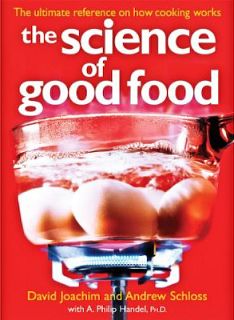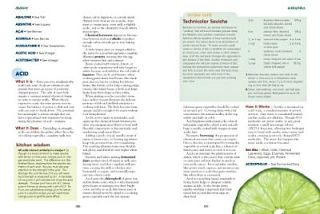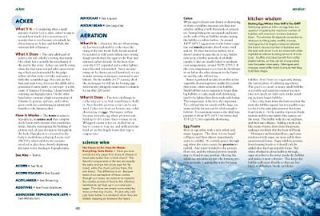
The Science of Good Food comes with the tag line "The ultimate reference on how cooking works" which is a bit of a stretch. It does cover a wide variety of topics in its 604 full color glossy pages, but it isn't fully comprehensive. What it does do well is explaining the science in easy to understand language. The entries have just enough complexity for the curious to satisfy their appetites without diving into so much detail that a pedestrian reader would feel intimidated and stop reading.
Sixteen hundred entries are arranged alphabetically and every entry that I've read has a "What It Is" (covering the basic definition of the entry including some history), "What It Does" (covering how the term relates to cooking), and "How It Works" section (covering the science behind why it does what it does). "Science Wise" and "Fast Facts" boxes littered throughout the entries provides additional scientific info and trivia while "Kitchen Wisdom" boxes provide interesting tips that can be applied to your cooking.
 Entries are heavily cross-referenced (through bold faced words and phrases as well as "See Also" sections at the end of each entry) and many additional terms "redirect" you to the entry containing the most relevant information. For example, when I looked up the term "garlic" I found that I should read about "Allium" instead. There I found information covering garlic, leek, shallot, and onions. Since the members of the Allium genera affect food similarly (and for similar reasons), reading about the group in general makes sense. I also found a chart comparing various alliums like chives, cipollini onions, ramps, scallions, and shallots, an easy recipe for caramelized onions (one of over 100 recipes in the book), and a "Kitchen Wisdom" section on some tips to help keep you from tearing up as you chop onions. This last bit was a little disappointing as it promotes some "faulty" tips such as chopping near a lit candle (which if you've ever tried doesn't really do anything - you'll probably need a series of Bunsen burners set up around your cutting board for it to be effective, but then you can't safely cut the onions).
Entries are heavily cross-referenced (through bold faced words and phrases as well as "See Also" sections at the end of each entry) and many additional terms "redirect" you to the entry containing the most relevant information. For example, when I looked up the term "garlic" I found that I should read about "Allium" instead. There I found information covering garlic, leek, shallot, and onions. Since the members of the Allium genera affect food similarly (and for similar reasons), reading about the group in general makes sense. I also found a chart comparing various alliums like chives, cipollini onions, ramps, scallions, and shallots, an easy recipe for caramelized onions (one of over 100 recipes in the book), and a "Kitchen Wisdom" section on some tips to help keep you from tearing up as you chop onions. This last bit was a little disappointing as it promotes some "faulty" tips such as chopping near a lit candle (which if you've ever tried doesn't really do anything - you'll probably need a series of Bunsen burners set up around your cutting board for it to be effective, but then you can't safely cut the onions).Speaking of faulty science, I was particularly irked by the mention of cholesterol as one of the fats found in egg yolk (cholesterol is not a fat, it's a sterol or alcohol which is fat-soluble). In the cholesterol entry, it starts off with "A soft, waxy lipid (a type of fat)..." which is also kind of wrong. Since cholesterol is fat soluble it is a lipid, but fats are type of lipid, not the other way around. Vitamin A is a lipid, but is not a fat. Similarly, cholesterol is a lipid but not a fat. But, here I'm nitpicking - on the whole the book is quite good and most people won't be focused on exact definitions.
 The layout of The Science of Good Food is very pleasing. Printed on 8-in. by 10-in. high contrast white pages in two columns in relatively a large serif font with bold sans serif section headings and subheadings, the text is easy to read and aesthetically pleasing. The photographs chosen were also excellent - mostly they get you thinking about the food topic, technique, or concept instead of actually illustrating anything in particular, but in this book it works well. Although rare, the illustrations (like the anatomy of a knife or beef chart) are extremely well designed and easy to understand and interpret.
The layout of The Science of Good Food is very pleasing. Printed on 8-in. by 10-in. high contrast white pages in two columns in relatively a large serif font with bold sans serif section headings and subheadings, the text is easy to read and aesthetically pleasing. The photographs chosen were also excellent - mostly they get you thinking about the food topic, technique, or concept instead of actually illustrating anything in particular, but in this book it works well. Although rare, the illustrations (like the anatomy of a knife or beef chart) are extremely well designed and easy to understand and interpret.One last reason to check out this book is something I discovered when skimming the bibliography. Under "Websites", Cooking For Engineers is listed as a reference!
The Science of Good Food is available in the following formats:
Paperback